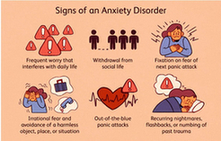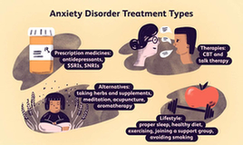Exploring Anxiety Disorders:
First of the 10 Types of Mental Disorder
Millions of people throughout the world are affected by anxiety disorders, which are among the most common mental health issues. The specifics of anxiety disorders, including their many subtypes, symptoms, suspected causes, and accessible treatments, will be covered in this page. By developing a greater knowledge of anxiety disorders, we may contribute to the elimination of the stigma associated with mental health and the promotion of successful treatment strategies.
Advertisement
What Are Anxiety Disorders?
A category of mental health illnesses known as anxiety disorders are characterized by excessive and enduring sensations of dread, concern, or uneasiness. Overwhelming and frequently interfering with daily life, these emotions make it difficult for people to engage in routine tasks and preserve good relationships.
Subtypes of Anxiety Disorders
There are several varieties of anxiety disorders, and each has a unique set of characteristics and signs:
1. Generalized Anxiety Disorder (GAD)
Chronic and excessive anxiety about many elements of life, even when there is little or no cause for worry, is a symptom of GAD. GAD sufferers may be agitated, irritable, tense in their muscles, and have trouble focusing.
2. Panic Disorder
Unexpected panic episodes that happen frequently are the hallmark of panic disorder. A racing heart, shortness of breath, and perspiration are some of the physical symptoms that go along with these episodes, which are abrupt bursts of great dread or pain.
3. Social Anxiety Disorder
An extreme dread of social events and interactions is referred to as social anxiety disorder or social phobia. People who with this illness can worry excessively about being criticized or ashamed in front of others.
4. Specific Phobias
Intense phobias of certain things or circumstances, including heights, spiders, or flying, are known as specific phobias. Anxiety and panic attacks can be brought on by exposure to the phobic stimuli.
5. Agoraphobia
Agoraphobia is a dread of circumstances in which getting out might be challenging or embarrassing, which causes avoidance of locations like crowded areas or public transit. This anxiety may render one helpless and lonely.
Symptoms of Anxiety Disorders
The physical and mental signs of anxiety disorders might differ greatly from person to person. Typical signs include:
excessive worry: Constantly experiencing anxiety or trepidation for no discernible cause.
Unable to sit still or feeling tense are both examples of restlessness.
Physical symptoms: Feelings of shaking, sweating, fast pulse, and dizziness.
Finding it difficult to concentrate on things owing to rushing thoughts and worry.
Being quickly upset or agitated is known as irritability.
Sleep disturbances: Struggling to get asleep or remain asleep as a result of worrying thoughts.
Causes and Risk Factors
.

0 comments: